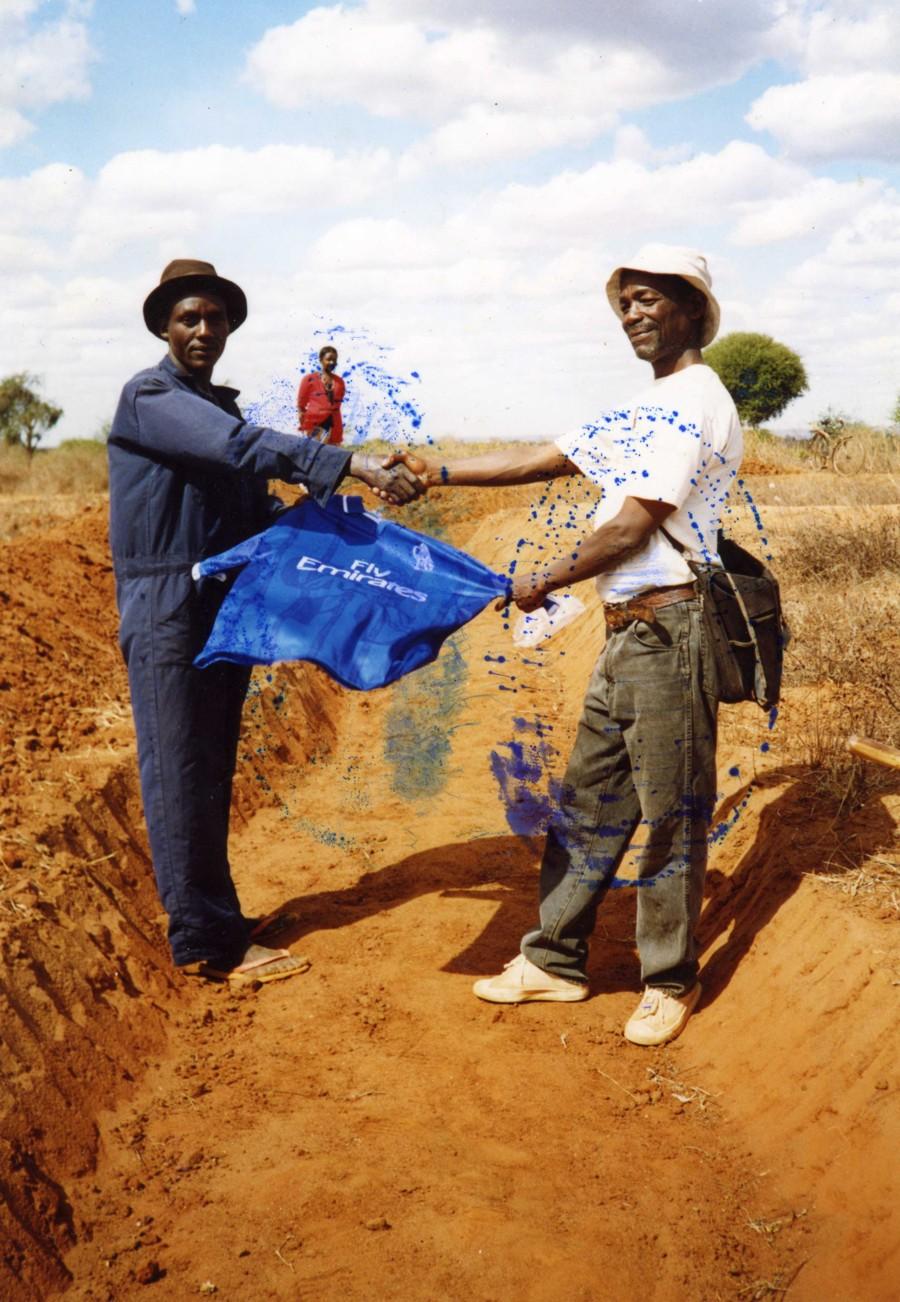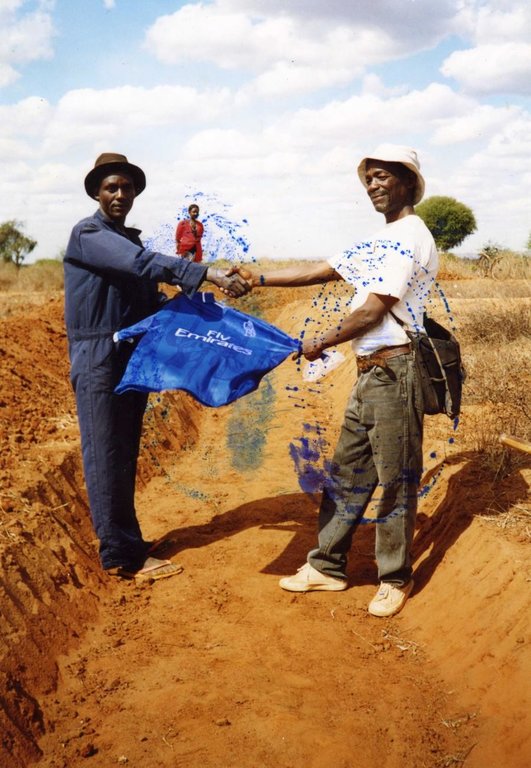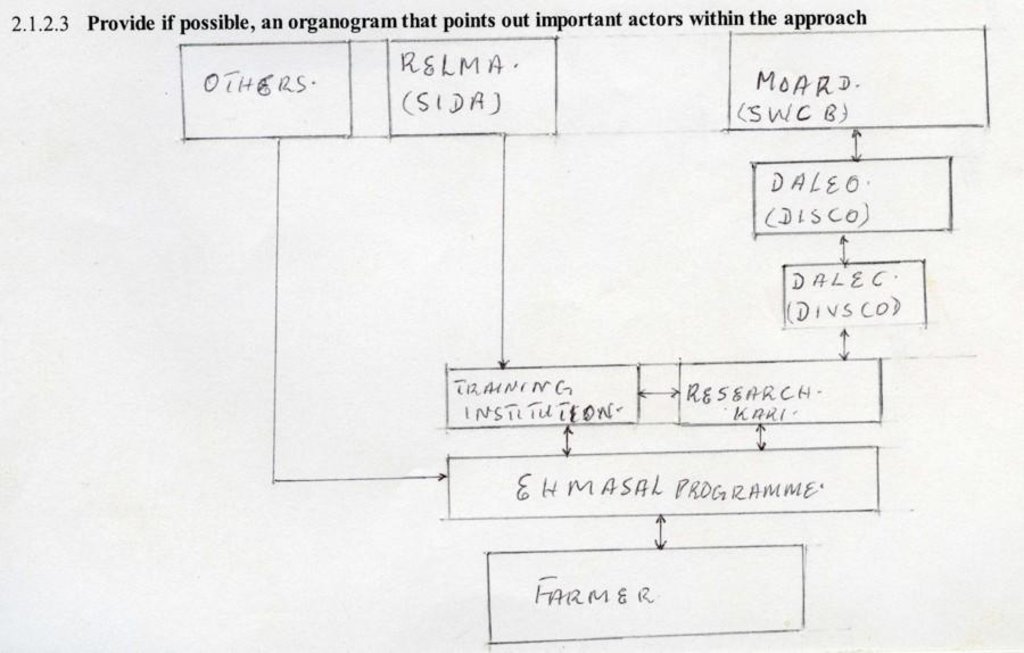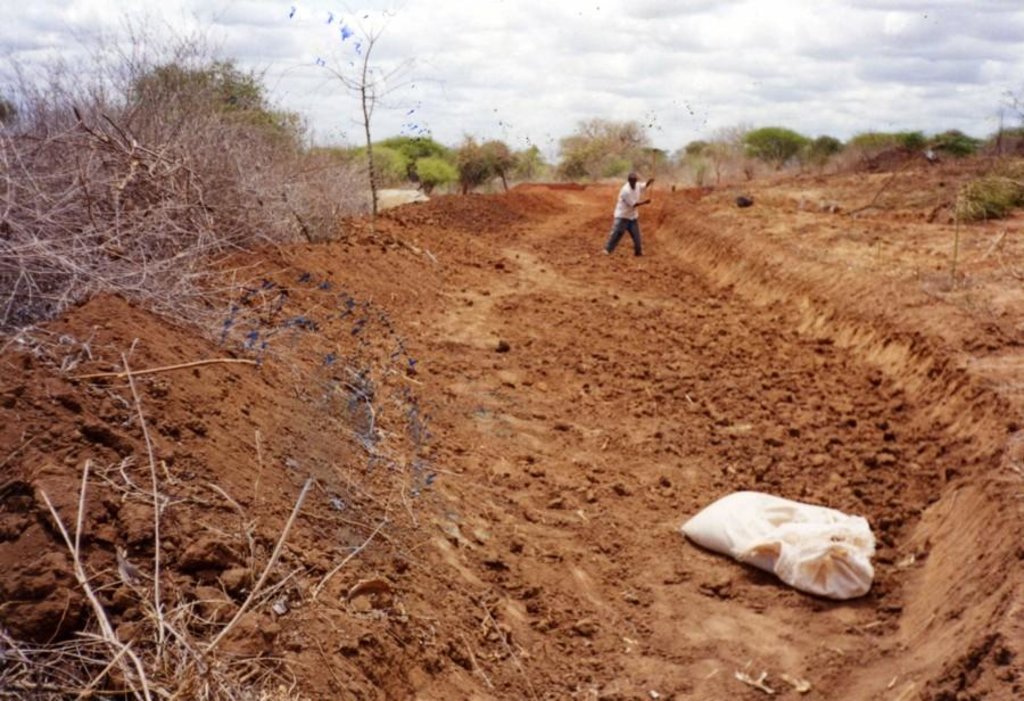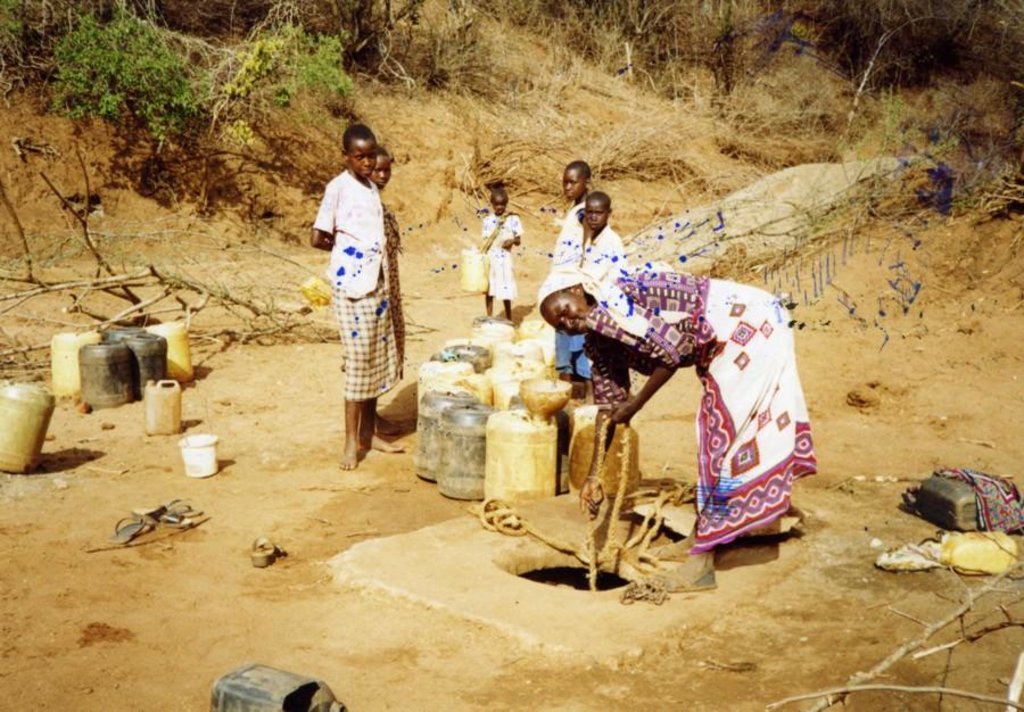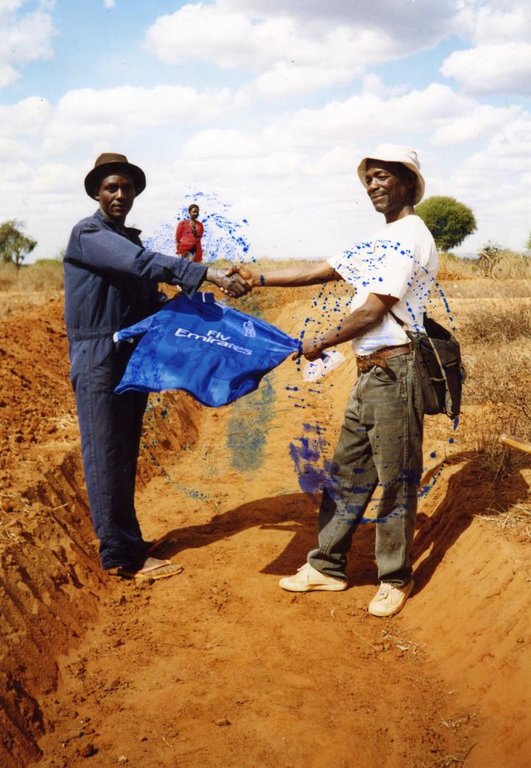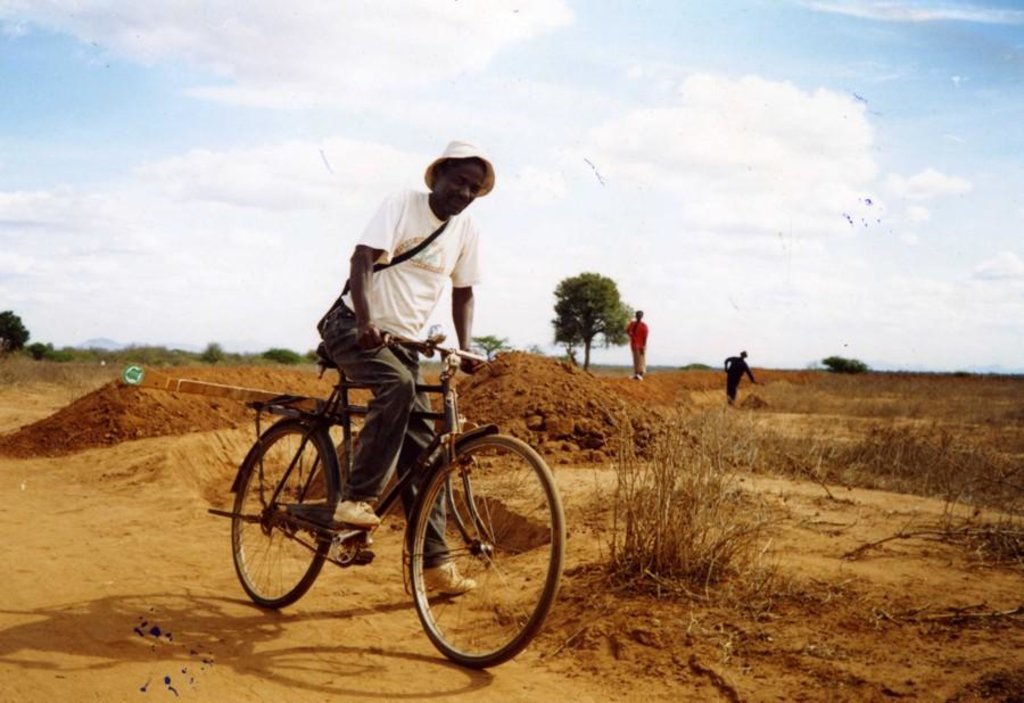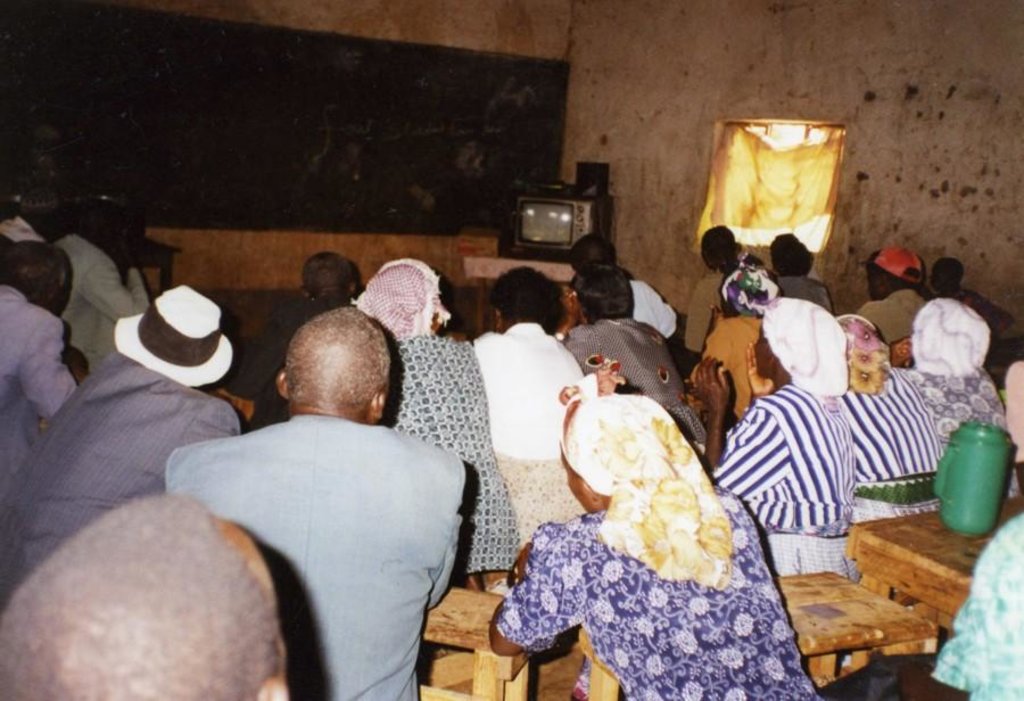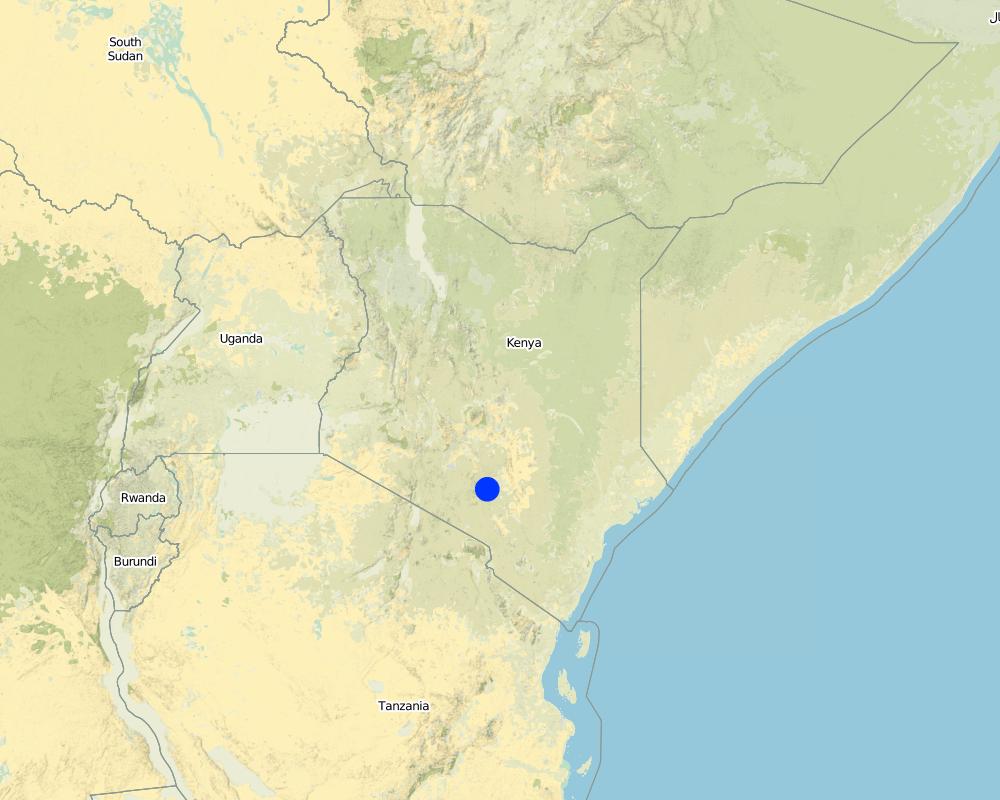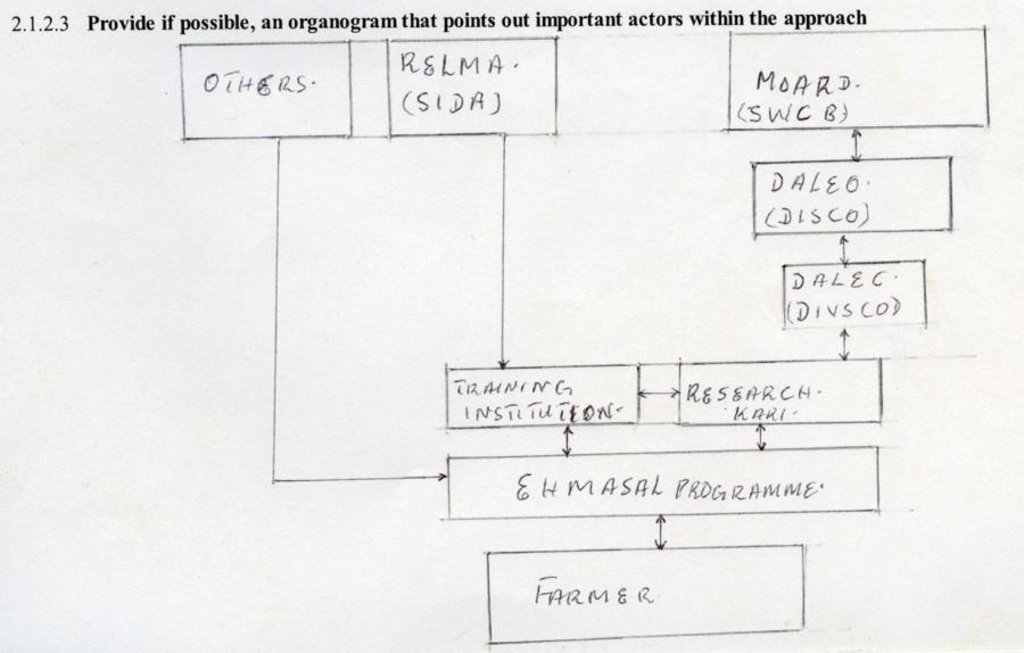water harvesting [肯尼亚]
- 创建:
- 更新:
- 编制者: Philippe Zahner
- 编辑者: –
- 审查者: Fabian Ottiger
approaches_2356 - 肯尼亚
查看章节
全部展开 全部收起1. 一般信息
1.2 参与方法评估和文件编制的资源人员和机构的联系方式
SLM专业人员:
SLM专业人员:
Mutunga Kathinji
Ministry of agriculture and rural development national SWC branch.
P.O.Box 30028 Nairobi
肯尼亚
SLM专业人员:
Adual Alex R.
RELMA/SIDA ICRAF house
P.O.Box 63403 Nairobi
肯尼亚
有助于对方法进行记录/评估的机构名称(如相关)
Swiss Agency for Development and Cooperation (DEZA / COSUDE / DDC / SDC) - 瑞士有助于对方法进行记录/评估的机构名称(如相关)
Ministry of Agriculture and Livestock Development of Kenya (MoA) - 肯尼亚有助于对方法进行记录/评估的机构名称(如相关)
International Centre for Research in Agroforestry (ICRAF) - 肯尼亚1.3 关于使用通过WOCAT记录的数据的条件
编制者和关键资源人员接受有关使用通过WOCAT记录数据的条件。:
是
1.4 SLM技术问卷的参考
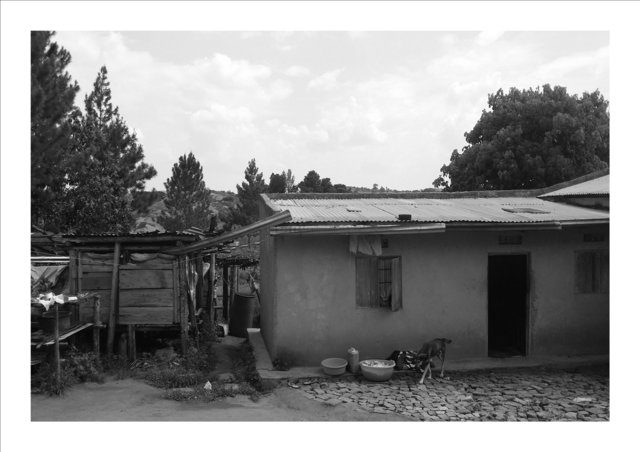
Wooden water reservoir for rain water harvesting. [乌干达]
A gutter system constructed on the farmer’s house-roof collects rainwater and directs it into a constructed reservoir raised off the ground with interior walls lined with water-proof tarpaulin. The reservoir has a maximum capacity of 8,000 liters of water; clean enough for irrigation, livestock and domestic use during seasons of …
- 编制者: Aine Amon
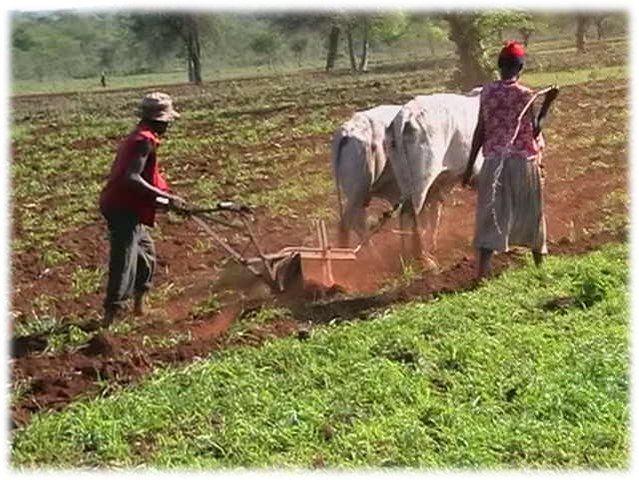
Micro-catchments for rainwater harvesting [肯尼亚]
Ox-ploughed furrow micro-catchments are intentionally built as part of seedbed preparation to harvest rainwater. Commonly used in dryland environments, the micro-catchment prolong water availability for seed germination and growth and development of the emerging seedlings.
- 编制者: Kevin Mganga
2. SLM方法的描述
2.1 该方法的简要说明
Water harvesting for agricultural production in ASALS.
2.2 该方法的详细说明
该方法的详细说明:
Aims / objectives: Water harvesting to enhance extra moisture and for reduced risks of crop failure. The technology combines retention/infiltration ditches, bench terraces, appropriate tillaging, manure use, water channels diverting run off from either high ways or natural waterways and stabilization of SWC embankment. Implementation is made by land users with guidance of SWC specialists. Land users may be a group or individual, though the land use type is individual ownership.
Other important information: Most of part 2: specification of SWC approach, QA2.11.3-QA2.5.2.3 were answered with assumptions since there never existed other projects in the area before this indigeneous one known as extra humid in arid and semi-arid lands (EHMASAL) programme established in 2000 to provide land users with the existing SWC technologies and methods of approaches to meet the prevailing need of self-sufficience and food security. The programme strategies are attached.
2.3 该方法的照片
2.5 采用该方法的国家/地区/地点
国家:
肯尼亚
区域/州/省:
Eastern province
Map
×2.6 该方法的开始和终止日期
注明开始年份:
2000
2.7 方法的类型
- 基于项目/方案
2.8 该方法的主要目的/目标
The Approach focused mainly on SLM with other activities (Timeliness in planting/transplanting, seed selection, seedlings variety and breeds for the AEZ.)
To harvest runoff and spread it on cropped area to maximize agricultural productivity. To improve crop moisture requiremnet. To reduce risks of crop failure stimulated by aridity in ASALs. To control soil erosion by water and wind. To improve the inflitration rate. To enhance food security for self-sufficiency and reliance.
The SLM Approach addressed the following problems: Inadequency of soil moisture resulting to crop failure. Inefficiency of approach to improve the situation. Fertility depletion due to continuous cultivation. Soil crusting caused by erosion, poor tillaging, overgrazing and deforestation (degadation).
2.9 推动或妨碍实施本办法所适用的技术的条件
财务资源和服务的可用性/可得性
- 阻碍
The much need be done on SWC in ASAL is beyond the sole land user for hand
Treatment through the SLM Approach: It requires financial support by source of loans and market orientation
法律框架(土地使用权、土地和水使用权)
- 启动
The existing land ownership, land use rights / water rights greatly helped the approach implementation: Land ownership/land use rights help implementation of the approach since benefits are realized by the sole land user.
- 阻碍
No empowerment on land use law or bylaws
Treatment through the SLM Approach: Enforcement by legislation on land use policy.
了解SLM,获得技术支持
- 阻碍
poor land treatment-plans, poor land husbandry, low knowledge
Treatment through the SLM Approach: Interaction in land use change, especially with SWC specialists
3. 相关利益相关者的参与和角色
3.1 该方法涉及的利益相关者及其职责
- 当地土地使用者/当地社区
Land user/local SWC specialists. Working land users were work equally divided between men and women (The family leader organizes for activity implementation either family labour or casuals). Women are majority for reason that men are engaged on off-farm. Employmentproportion is about 3 women to 1 man. Mostly women in public meetings and open field days
- SLM专家/农业顾问
- 国家政府(规划者、决策者)
Water harvest for agricultural production RESCU 1996. Run off farming ministry of agriculture, Nairobi
3.2 当地土地使用者/当地社区参与该方法的不同阶段
| 当地土地使用者/当地社区的参与 | 指定参与人员并描述活动 | |
|---|---|---|
| 启动/动机 | 互动 | Mainly:public meetings; partly: workshops/seminars; public meetings for initial awareness. Workshops/seminars for technical assistance for approach |
| 计划 | 互动 | Mainly: workshops/seminars; partly: public meetings; innovators land users seminar |
| 实施 | 自我动员 | |
| 监测/评估 | 无 | Mainly: reporting; partly: measurements/observations; correct dimensions, monthly progress report |
| Research | 无 |
3.3 流程图(如可用)
3.4 有关SLM技术选择的决策
具体说明谁有权决定选择要实施的技术:
- 主要是SLM专家,咨询土地使用者之后
解释:
consultative for land use change
Decisions on the method of implementing the SLM Technology were made by mainly by land users supported by SLM specialists. land users implemented voluntarily.
4. 技术支持、能力建设和知识管理
4.1 能力建设/培训
是否为土地使用者/其他利益相关者提供培训?:
是
明确受训人员:
- 土地使用者
- extensionists/trainers
培训形式:
- 在职
- 示范区域
- 公开会议
涵盖的主题:
Only field days and practical substitutes training for a fact that the programme has no source of finance to support trainings.
4.2 咨询服务
土地使用者有权使用咨询服务吗?:
是
说明/注释:
Runoff farming (water harvesting); Key elements: Infiltration/retention ditches, level bench terraces, soil structure, texture and fertility improvement, macro/micro catchment water harvest bund; 1) Advisory service was carried out through: non-governmental agency 2) Target groups for extension: land users; Activities: SWC activities, water harvest
Advisory service is inadequate to ensure the continuation of land conservation activities; Staff farmer ratio is too high to induce land use change
4.3 机构强化(组织发展)
是否通过这种方法建立或加强了机构?:
- 是,少许
具体说明机构的强化或建立程度:
- 本地
具体说明支持类型:
- 能力建设/培训
4.4 监测和评估
监测和评估是该方法的一部分吗?:
是
注释:
Area treated aspects were regular monitored through measurements
no. of land users involved aspects were ad hoc monitored through observations
There were no changes in the Approach as a result of monitoring and evaluation: The changes may come up season after season due to rainfall characteristics in arid areas. The period is rather short to make a conclusion. No change observed hither to.
4.5 研究
研究是该方法的一部分吗?
是
明确话题:
- 生态学
- 技术
提供进一步的细节,并指出是谁做的研究:
The existing SWC recommendations were released through the institution
Research was carried out both on station and on-farm
5. 融资和外部物质支持
5.1 该方法中SLM组成部分的年度预算
如果不知道准确的年度预算,请给出一个范围:
- 10,000-100,000
注释(例如主要的资助来源/主要捐助者):
Approach costs were met by the following donors: local community / land user(s) (no external support)
5.3 对特定投入的补贴(包括劳动力)
如果土地使用者的劳动力是一项重要的投入,那么是不是:
- 自愿
5.4 信用
是否根据SLM活动的方法给予信用值?:
否
6. 影响分析和结论性陈述
6.1 方法的影响
该方法是否帮助土地使用者实施和维护SLM技术?:
- 否
- 是,很少
- 是,中等
- 是,支持力度很大
soil management structurally aiming to make use of previously lost runoff for crop production.
该方法是否改善了阻碍SLM技术实施的土地使用权/用户权问题?:
- 否
- 是,很少
- 是,中等
- 是,支持力度很大
Did other land users / projects adopt the Approach?
- 否
- 是,很少
- 是,中等
- 是,支持力度很大
about 20-25% of the other organized groups adopted the approach initially.
6.3 方法活动的可持续性
土地使用者能否维持通过该方法实施的措施(无外部支持的情况下)?:
- 是
若是,请说明如何维持:
About 75% of the land users may continue implementing the SWC activities without financial support in future. What would be required by land user as focused is layout, alignment, generally technology guidance. If other approaches e.g. trainings/seminars were included to all farm production systems.
6.4 该方法的长处/优点
| 土地使用者眼中的长处/优势/机会 |
|---|
| increase weight on food security (How to sustain/ enhance this strength: to acquire knowledge of the land husbandry.) |
| introduces off-farm employment (How to sustain/ enhance this strength: proper measures and practices of water harvesting component.) |
| 编制者或其他关键资源人员认为的长处/优势/机会 |
|---|
| The approach focuses on food security and self-sufficiency. (How to sustain/ enhance this strength: Regular maintenance of the SWC structures and agroforestry establishment.) |
| Improve the standard of living if adopted by the community. (How to sustain/ enhance this strength: Enforcement of SWC policy by the government to protect technology areas.) |
| Reduces risk of crop failure due to poor rainfall distribution. (How to sustain/ enhance this strength: Introduce policy of land use right/land ownership.) |
| Reduces soil and water losses through erosion. (How to sustain/ enhance this strength: Introduced land use change and land management (land husbandry practices)) |
| Improves national economy as well as family gross income. (How to sustain/ enhance this strength: improvement on market of agricultural products and by-products.) |
6.5 该方法的弱点/缺点以及克服它们的方法
| 土地使用者认为的弱点/缺点/风险 | 如何克服它们? |
|---|---|
| poor marketing system for most of agricultural products and byproducts. | formation of cooperative societies |
| slow in adoption on land use change due to longer period of cost return | government introduces enforcement law to discourage communal land use. |
| 编制者或其他关键资源人员认为的弱点/缺点/风险 | 如何克服它们? |
|---|---|
| regular crop failure due to erratic rainfall patterns | enhance extra moisture by water harvest and spreading it in cropped area |
| consumes time, energy and money to establish. | No soil, no food. No water, no life. Policy of approach |
| interferes with soil fertility and reduces land size by SWC structures. | Manure and fertilizer application regularly to maximize production level. |
| Slow in cost benefit return from a given area. | marketing orientation for farm products |
| Low income sources of the common land users. | Introduced sources of agricultural loan policy for ASALs. |
7. 参考和链接
7.2 参考可用出版物
标题、作者、年份、ISBN:
SWC manual for Kenya 1997 by D.B. ThomasSoil conservation in Kenya 1981 by C.G.WennerSWC technology development in Kenya by K:MutungaSony super DXE-180 videoThe sun will still rise videoRunoff, a friend or a foe video
可以从哪里获得?成本如何?
agricultiral information centre, freeagricultiral information centre, freeM.A.R.D. SWCB-NBI Kenya, freeSWCB NBI Kenya, freeRELMA/CIDA, freeRELMA/CIDA, free
标题、作者、年份、ISBN:
Rainfall runoff analysis by Paul Kimeu. 1-11. Feb. 1998
标题、作者、年份、ISBN:
Water conservation, water harvesting and management (WCHM) scheme design. Practicals (WHIF) exercise. Embu February 1-11 1998
标题、作者、年份、ISBN:
Method of collecting and storing local surface runoff for water supply in central Asian deserts by Prof A.G. Babaer
可以从哪里获得?成本如何?
Desert research institute, Gogolstr.15.
标题、作者、年份、ISBN:
Study of traditional water harvesting practices in Cost province, by J.O.Owupo, July 1998
标题、作者、年份、ISBN:
Soil characteristics and properties for water conservation, harvesting and management (WCHM). (WH5) June 29-July 7 1997 by Kithinji Mutunga
标题、作者、年份、ISBN:
Dryland water harvesting (WH), water conservtion (WC) techniques , by K. Mutunga 9-15 July 1995
标题、作者、年份、ISBN:
Design procedure for harvesting and conservation system, by Odoyo J. Bittar. ministry of agriculture, Busia-Kenya, February 1-11, 1998
标题、作者、年份、ISBN:
MINOR ROADS PROGRAMME soil conservation. Pilot project final report 1992agrisystems (EA) Ltd, P.O.Box 39636 Nairobi, free
可以从哪里获得?成本如何?
Agrisystems (EA) Ltd, P.O.Box 39636 Nairobi, free
标题、作者、年份、ISBN:
promoting farmer innovatiion . Workshop report No. 2 by Will Critchley 'RELMA' 1999
可以从哪里获得?成本如何?
Free
标题、作者、年份、ISBN:
mpact assessment study. National soil and water conservation branch, final report 1998
可以从哪里获得?成本如何?
Agrisystems (EA) Ltd, P.O.Box 39636 Nairobi, free
标题、作者、年份、ISBN:
The sustainability of the catchment approach - induced measures and activities, by Yeraswara Admasie (NSWCP). Report in 1998
可以从哪里获得?成本如何?
Free
标题、作者、年份、ISBN:
Where ther is no water. SASOL and by Donald B.Thomas 1999. maji na ufanisi P.O.Box 14893 Nairobi
可以从哪里获得?成本如何?
Free
标题、作者、年份、ISBN:
ater from sand rivers by Erik Nissen Petersen report No.23, RELMA/SIDA. Kenya 2000
标题、作者、年份、ISBN:
Agroforestry extension manual for northern Zambia, by Henry Chilufya. BO Tengrias , free. RSCU Nairobi technical handbook No.11.
标题、作者、年份、ISBN:
The hand of man. Soil conservation in Kondoa, eroded area Tanzania, by Carl Christiansson, Alfred Mbegu, Andreas Yrgard, RSCU/SIDA 1993 free
标题、作者、年份、ISBN:
Nomadic pastoral appraisal SWCB MALDM P.O. Box 30028 Nairobi, by L.I. Mwarasomba
标题、作者、年份、ISBN:
Curriculum for in service training in agroforestry and related subjects in Kenya. By Stachys M. Muturi. M.A., MENR, Kenya. Forestry research institute, RSCU/SIDA 1992
链接和模块
全部展开 全部收起链接

Wooden water reservoir for rain water harvesting. [乌干达]
A gutter system constructed on the farmer’s house-roof collects rainwater and directs it into a constructed reservoir raised off the ground with interior walls lined with water-proof tarpaulin. The reservoir has a maximum capacity of 8,000 liters of water; clean enough for irrigation, livestock and domestic use during seasons of …
- 编制者: Aine Amon

Micro-catchments for rainwater harvesting [肯尼亚]
Ox-ploughed furrow micro-catchments are intentionally built as part of seedbed preparation to harvest rainwater. Commonly used in dryland environments, the micro-catchment prolong water availability for seed germination and growth and development of the emerging seedlings.
- 编制者: Kevin Mganga
模块
无模块


